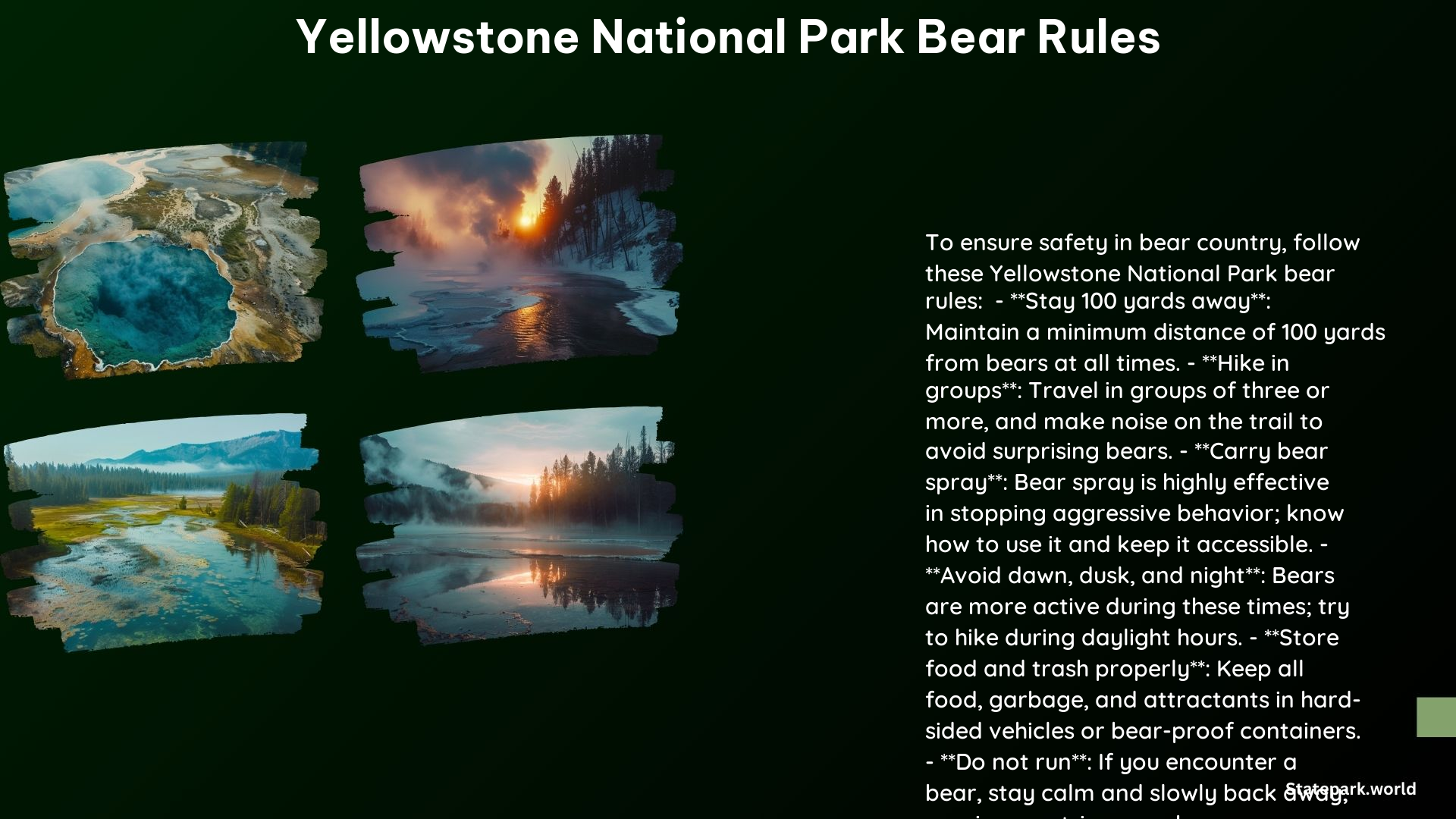Yellowstone National Park is home to a diverse array of wildlife, including the iconic grizzly and black bears. To ensure the safety of both visitors and bears, the park has established strict rules and guidelines that all tourists must follow. In this comprehensive blog post, we’ll dive into the essential Yellowstone National Park bear rules, management areas, and safety measures to help you navigate the park with confidence.
Bear Safety Tips
- Keep Your Distance: Maintain a minimum distance of 100 yards (93 meters) from bears at all times. Never approach a bear or attempt to feed it, as this can be extremely dangerous.
- Carry Bear Spray: Equip yourself with bear spray and know how to use it effectively. Bear spray has proven to be highly successful in deterring aggressive bear behavior.
- Travel in Groups: Hike in groups of three or more people and make noise while on the trail to avoid surprising bears.
- Avoid Dawn, Dusk, and Night: Bears are more active during the early morning and evening hours, so it’s best to avoid hiking during these times.
- Don’t Run: If you encounter a bear, do not run. Instead, slowly back away while keeping the bear in sight.
- Store Food and Garbage Properly: Use bear-proof containers or hang your food and garbage at least 10 feet off the ground and 4 feet out from the trunk to prevent attracting bears.
- Report Sightings and Encounters: Immediately notify a park ranger if you spot a bear or have an encounter.
Bear Management Areas

Yellowstone National Park has designated specific areas with heightened bear management protocols to protect both visitors and bears.
- Hayden Valley Bear Management Area: This area prohibits off-trail travel from July 15 to September 15 to minimize disturbance to bears and ensure visitor safety.
- Firehole River Bear Management Area: This area has been decommissioned due to fewer wildlife conflicts, allowing access to popular trails like Midway Geyser Basin Overlook, Fairy Falls, and Mystic Falls.
Additional Safety Measures
- Hypothermia Prevention: Bring appropriate clothing and gear to stay warm and dry, as hypothermia can be a significant risk in Yellowstone’s unpredictable weather.
- Stream Crossings: Exercise caution when crossing rivers and streams, especially during the late summer when water levels are higher.
Bear Encounter Procedures
- Surprise Encounters: If a bear approaches, remain calm and slowly back away while keeping the bear in sight. Do not run.
- Charging Bears: Stand your ground and deploy your bear spray when the bear is within 60 feet (18 meters) or less. If the bear leaves, immediately leave the area.
- Attacks: If a bear attacks, fight back using any available weapons, such as rocks or sticks, as if your life depends on it.
Bear Conservation
Yellowstone National Park is committed to the conservation of its bear populations. The park works to manage bear-human conflicts and educate visitors on bear safety to ensure the long-term survival of these magnificent creatures.
Statistics and Incidents
- Bear Attacks: On average, there is one bear attack per year in Yellowstone National Park. In 2011 and 2015, three visitors were tragically killed by bears inside the park.
- Bear Sightings: The first grizzly bear sighting of 2024 occurred on March 3, and the first bear sighting of 2023 occurred on March 7.
Resources
For more detailed information on bear safety and management in Yellowstone National Park, be sure to consult the following resources:
- National Park Service (NPS) Guidelines: https://www.nps.gov/yell/planyourvisit/backcountrysafety.htm
- Yellowstone National Park Lodges: https://www.yellowstonenationalparklodges.com/connect/yellowstone-hot-spot/essential-bear-safety-in-yellowstone/
- Yellowstone Park: https://www.yellowstonepark.com/things-to-do/wildlife/precautions-in-bear-country/
- Yellowstone Guidelines: https://www.yellowstoneguidelines.com/the-area/bear-and-animal-safety.html
By familiarizing yourself with the Yellowstone National Park bear rules and safety guidelines, you can enjoy your visit to the park while respecting the wildlife and ensuring your own safety. Remember, a little preparation can go a long way in making your Yellowstone adventure a memorable and safe one.
References
National Park Service. (2024). Backcountry Safety – Yellowstone National Park. Retrieved from https://www.nps.gov/yell/planyourvisit/backcountrysafety.htm
Yellowstone National Park Lodges. (2023). Essential Bear Safety in Yellowstone National Park, WY. Retrieved from https://www.yellowstonenationalparklodges.com/connect/yellowstone-hot-spot/essential-bear-safety-in-yellowstone/
Yellowstone Park. (2022). What to Do If You Encounter a Bear at Yellowstone. Retrieved from https://www.yellowstonepark.com/things-to-do/wildlife/precautions-in-bear-country/
National Park Service. (2024). Yellowstone National Park Increases Protection for Bears and Visitor Safety. Retrieved from https://www.nps.gov/yell/learn/news/24008.htm
Yellowstone Guidelines. (n.d.). Bear and Animal Safety in Yellowstone. Retrieved from https://www.yellowstoneguidelines.com/the-area/bear-and-animal-safety.html
